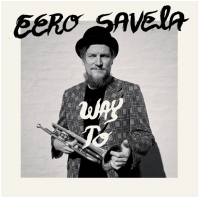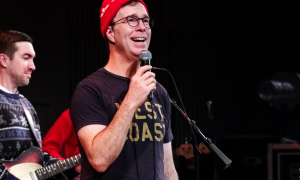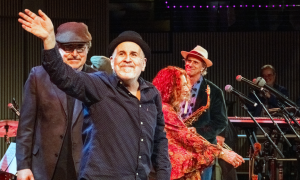Home » Jazz Articles » Live Review » Ottawa Jazz Festival 2010: Days 7-9, June 30-July 2, 2010
Ottawa Jazz Festival 2010: Days 7-9, June 30-July 2, 2010
radio.string.quartet.vienna / Tord Gustavsen Ensemble
TD Ottawa International Jazz Festival
Ottawa, Ontario, Canada
June 30-July 2, 2010
As the 30th Anniversary of the TD Ottawa International Jazz Festival enters the home stretch, it once again provided a day of free programming on Canada Day, July 1, in collaboration with the National Capital Commission. With the city closing down the streets in the downtown core to accommodate the tens of thousands—sometimes hundreds of thousands—of Canadians who come to celebrate the country's birthday, OIJF provides shows at Confederation Park, starting at 11:00AM and running through to the early evening, when the main event, televised across the country, takes place a few blocks away at the Parliament Buildings, capped off with a tremendous fireworks show at 10:00PM.
Meanwhile, OIJF at thirty has turned out to be one of its most impressively diverse programs yet, with something for everyone. If your bag is mainstream jazz, the Anniversary series at Library and Archives Canada—as well as many of the shows at the main stage at Confederation Park—are for you. If you lean more left-of-center, the Improv Invitational and new Friends series at the National Arts Centre are right up your alley. And if your tastes lean to, well, everything, then you're forced to make some tough decisions. But compared to most other festivals, and certainly those in Canada, OIJF may have a program bursting at the seams with terrific shows, but there are far fewer conflicts to encounter.
Chapter Index
June 30: radio.string.quartet.vienna
Still, choosing between radio.string.quartet.vienna and drummer Matt Wilson was a tough one, with the Viennese string quartet winning out only because this is its first North American tour/OIJF appearance, and Wilson is a regular at the festival. From the moment the quartet walked onstage it was clear that this wasn't your grandfather's string quartet; with the exception of cellist Asja Valcic, the quartet stood rather than being seated, and there were no microphones to be found on the truly spartan stage, because everyone in the quartet plugged in, with pickups on their instruments.
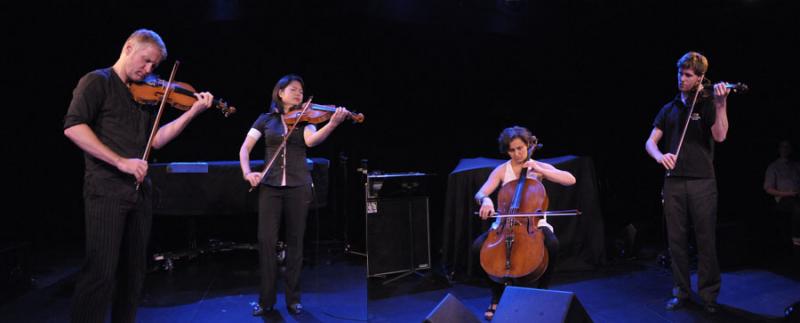 From left: Bernie Mallinger, Cynthia Liao, Asja Valcic, Johannes Dickbauer
From left: Bernie Mallinger, Cynthia Liao, Asja Valcic, Johannes Dickbauer Despite releasing three albums in the past four years, including Radiotree (ACT, 2008) and their recent collaboration with vocalist Rigmor Gustafsson, Calling You (ACT, 2010)—in addition to working with Swedish guitarist Ulf Wakenius (who performed at the OIJF festival the previous evening with singer Youn Sun Nah) on Love is Real: Ulf Wakenius Plays the Music of Esbjörn Svensson (ACT, 2008)—the quartet chose to focus exclusively on material from its stellar ACT debut, Celebrating the Mahavishnu Orchestra (2007). A sleeper hit that garnered plenty of critical acclaim upon its release, even Mahavishnu Orchestra founder/guitarist John McLaughlin was so impressed that he ultimately contributed liner notes for the disc, writing: "From the first note I was struck by the way this group had 'appropriated' my music and made it their very own. They even got the atmosphere which was present all those years ago."
Appropriate the music they did, from the very first notes of "Hope," where delicate harmonics from violinist Bernie Mallinger and violist Cynthia Liao gradually led into McLaughlin's ascending melody, as the quartet began to approach the music with greater power and intensity, segueing into the vicious title track from Mahavishnu Orchestra's classic Birds of Fire (Columbia, 1973). Contrapuntal pizzicato lines from Mallinger and violinist Johannes Dickbauer took the place of McLaughlin's original 12-string guitar arpeggios and more, as Valcic assumed the bass role to propel the irregular-metered tune along with surprising energy.
While the strings were plugged in—in order to avoid using microphones and allow the soundman even better control—this was still essentially an acoustic performance, interpreting music that was originally as loud as jet plane from 15 feet. Proving that dynamics create drama and not sheer volume, radio.string.quartet.vienna managed to capture the essence of Mahavishnu without making its audience's ears bleed—though many who witnessed the original group back in the early '70s did find its raw and unbridled debut, The Inner Mounting Flame (Columbia, 1971), a life-changing experience. The days of changing the lives of hundreds of thousands (millions, even) with this kind of music are, sadly, long gone due to a significantly changed industry landscape, but radio.string.quartet.vienna is undeniably forging its own path, even in a world where string quartet conventions are being challenged by groups like Kronos Quartet and Cikada String Quartet.
 Bernie Mallinger
Bernie Mallinger Just as Mahavishnu Orchestra traversed a broad musical terrain—incorporating elements of classical, Indian, country and rock into a groundbreaking musical mélange— so, too, did radio.string.quartet.vienna break ground in its own way, with a combination of outstanding arrangements and freewheeling improvisational acumen. Founded by Mallinger, whose formal training may have been classical, but whose personal interests and musical exploits range far and wide—and who arranged all the material on Celebrating, either alone or with Klemens Bittman—the hour-long set drew from the album, stretching the music for lengthier solos and, consequently, dropping a couple of tunes from the album, but performing the vast majority, albeit in a different sequence. An early highlight was Liao's feature on the delicate "Open Country Joy"—delicate, that was, until the propulsive middle section, with lighting fast linking phrases and, once again, Valcic propelling the tune from the bottom up. In the final section, Mallinger and Dickbauer proved that it's possible for classically trained musicians to swing with a country vibe.
Other high octane tunes like the encore, like the visceral, riff-based "Vital Transformation," kept the excitement level high during the set, but perhaps the best chart was "Dawn," another tune that began relatively quietly, but picked up steam in the second section. If radio.string.quartet.vienna had been around back in the day of Mahavishnu Orchestra—and if McLaughlin had already embraced the concept of a large group that he would a few years later for Apocalypse (Columbia, 1974) and Vision of the Emerald Beyond (Columbia, 1975), he might well have included radio.string.quartet.vienna's lush chart for the tune's serene opening.
For those in the audience who were familiar with Mahavishnu Orchestra's seminal recordings, it wasn't necessary for Mallinger to announce the song titles. For those who were experiencing the music of Mahavishnu Orchestra for the first time—filtered through radio.string.quartet.vienna's unique prism—it's a good possibility that, in addition to grabbing a copy of the CD at the show, they'll go back home and investigate McLaughlin's groundbreaking group.
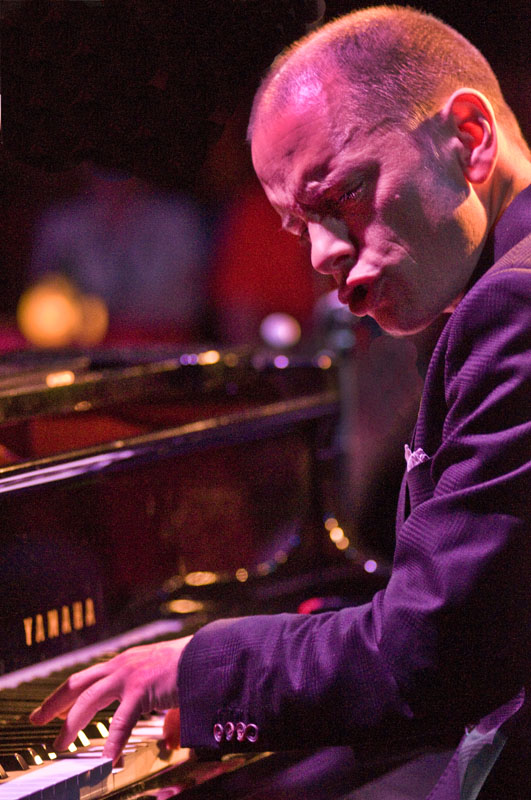 July 2: Tord Gustavsen Ensemble
July 2: Tord Gustavsen Ensemble Since releasing his ECM debut, Changing Places (2003), Norwegian pianist Tord Gustavsen has been mining an ever-expanding dynamic that—despite a predilection for slow tempos and generally gentle delivery—has demonstrated the tremendous power of understatement . On subsequent albums for the venerable German label including The Ground (2005) and Being There (2007)—like Changing Places, trio albums featuring bassist Harald Johansen and drummer Jarle Vestpestad—Gustavsen has continued his exploration of the infinite possibilities within a seemingly (but deceptively) limited temporal space, blending elements of gospel with hints of Spanish music, a clear European impressionism and Norwegian traditionalism, all refracted through a prism of the jazz vernacular.
Following Canadian guitarist Gordon Grdina's opening set with Box Cutter, the subtlety and grace of Gustavsen's show was brought into even sharper focus; the two groups as distanced from each other as humanly possible. Grdina's set was largely about high volume and high velocity; Gustavsen's music was often so quiet that it almost became necessary to lean forward to hear it, and the pianist played with elegant restraint and attention to space, only occasionally demonstrating, in an overt fashion, the unfailing virtuosity that underscored his music. Grdina's set was relentless, with few breaks in either pace or dynamics; Gustaven's music was all about careful attention to the spaces between the notes, and the subtlest gradation of tempo and dynamic. Despite exploring very specific musical terrain, Gustavsen's performance was the definition of variation—rich in emotion, texture, melody...and spontaneity.
The 80-minute set was a mix of two new compositions, two tracks from Being There (the soft, bittersweet waltz, "Still There," and more energetic, Spanish-tinged "Where We Went," featuring an equally restrained solo from saxophonist Tore Brunborg which, along with Gustavsen's own, threatened to boil over with unsettling tension), and material from Restored, Returned (ECM, 2009), a departure from Gustavsen's earlier trio discs in its expansion to include both Brunborg and singer Kristin Asbjørnsen. For Gustavsen's brief, three-date Canadian tour and first public Ottawa appearance—he delivered a short solo set at the home of the Norwegian ambassador in 2003 for a private audience, before traveling to Montreal the next day for his first ever Canadian appearance—the pianist brought Vespestad, Brunborg, and Restored, Returned bassist Mats Eilertsen.
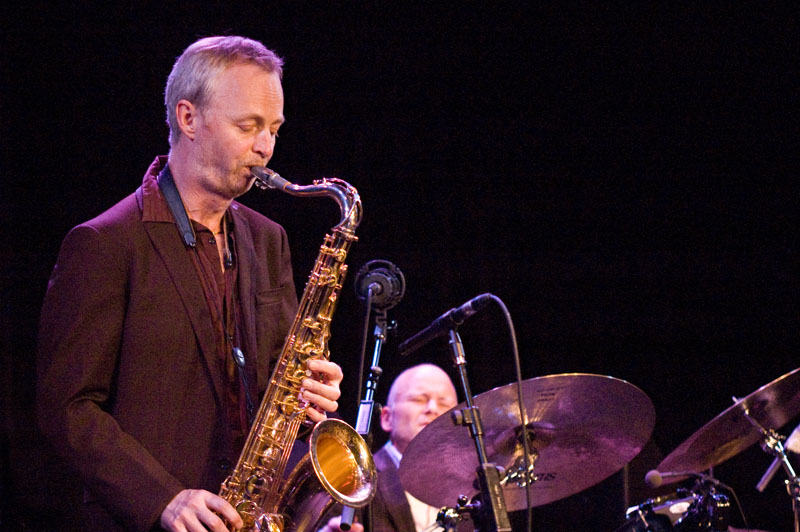 From left: Tore Brunborg, Jarle Vespestad
From left: Tore Brunborg, Jarle Vespestad Vespestad—who co-founded Supersilent but left the groundbreaking Norwegian noise improv group a couple years back to focus his attention on more specific areas—was, as ever, a player whose touch was light, with complete command of the many colors available to him, on his relatively small and curiously set-up kit. He used a variety of sticks—many of them homemade—to broaden the textural palette and allow him to play with a degree of power while never sacrificing the sense of quiet that Gustavsen's music demanded, with a solo at the end of the set that was the absolute antithesis of typical set-closing drum features. Beginning with just a bass drum and the remarkably varied colors available on but a single cymbal, he gradually built his solo, with occasional bursts of speed made all the more remarkable for his avoidance of the kind of high powered bashing to which most drummers resort. Instead, as was the case with the rest of the set, Vespestad kept his solo brief, but spoke a great deal in that short space.
Brunborg played with even greater restraint than he did two nights previous during his appearance with drummer Manu Katche—where he did, at least occasionally, demonstrate more overt virtuosity, just as Gustavsen did in this performance. With Jan Garbarek an unmistakable influence in the traditional lilt of his phrasing his and overall tone—though the Norwegian saxophone icon's sound has always been drier and more acerbic—Brunborg's presence gave Gustavsen's ensemble a sound not unlike Garbarek's famous quartet with pianist Bobo Stenson, bassist Palle Danielsson and drummer Jon Christensen. But whereas the legendary group that released Dansereer—on occasion, even as, at other times, he seemed to be barely breathing on his kit.
Eilertsen—no stranger to ECM fans for his ongoing work with guitarist Jacob Young on albums like the sublime Evening Falls (ECM, 2004), but equally, a player demonstrating a greater capacity for sonic violence at Crimetime Orchestra's at 2009 performance at Molde Jazz, and a bassist who is slowly building his own discography, including Radio Yonder (Hubro, 2009) , also featuring Brunborg—proved himself cut from the same cloth as the rest of his band mates. Possessing a rich, robust tone—all the more remarkable given the absolute quiet of the group—Eilertsen combined unusual techniques with a legato approach built on ascending glissandi for his opening a capella solo to a new tune, "Internal Dance." That it appears to be de rigueur for Norwegian groups to travel with their own soundman—rather than take a chance with one provided by the festival—only meant that Gustavsen was able to achieve as consistent a sound as possible, within any limitations of the venue or the piano provided.
 Mats Eiltertsen
Mats Eiltertsen As ever, Gustavsen was a soft-spoken but commanding presence; head down, left foot tapping the ground hard in time, with his body moving and occasionally even lifting off the piano bench as he dug into a long, lyrical and serpentine phrase—not unlike one of his seminal influences, Keith Jarrett, but without the loud groaning and, unsurprisingly, considerably more restraint. For the capacity crowd—people being turned away, but many remaining in the foyer of the Fourth Stage to watch Gustavsen's performance on a television monitor—Gustavsen's first Ottawa appearance was eagerly anticipated, and the pianist and his group delivered exactly what the audience had hoped for, and more. Hopefully the festival will bring him back again, but put him in a larger venue to support the audience he has gradually built over the last seven years.
Coming up on the final two days of the 2010 TD Ottawa International Jazz Festival: The Wide Alley, Neil Cowley Trio, Christian Scott aTunde Adjuah and Tomasz Stańko
Visit radio.string.quartet.vienna, Tord Gustavsen and TD Ottawa International Jazz Festival on the web.
Photo Credits
Page 1, radio.string.quartet.vienna: John R. Fowler
Page 1, Bernie Mallinger: John Kelman
Page 2, Tord Gustavsen: John R. Fowler
Page 2, All Other Photos: John Kelman
Days 1-3 | Days 4-6 | Days 7-9 | Days 10-11
Tags
PREVIOUS / NEXT
Support All About Jazz
 All About Jazz has been a pillar of jazz since 1995, championing it as an art form and, more importantly, supporting the musicians who make it. Our enduring commitment has made "AAJ" one of the most culturally important websites of its kind, read by hundreds of thousands of fans, musicians and industry figures every month.
All About Jazz has been a pillar of jazz since 1995, championing it as an art form and, more importantly, supporting the musicians who make it. Our enduring commitment has made "AAJ" one of the most culturally important websites of its kind, read by hundreds of thousands of fans, musicians and industry figures every month.












